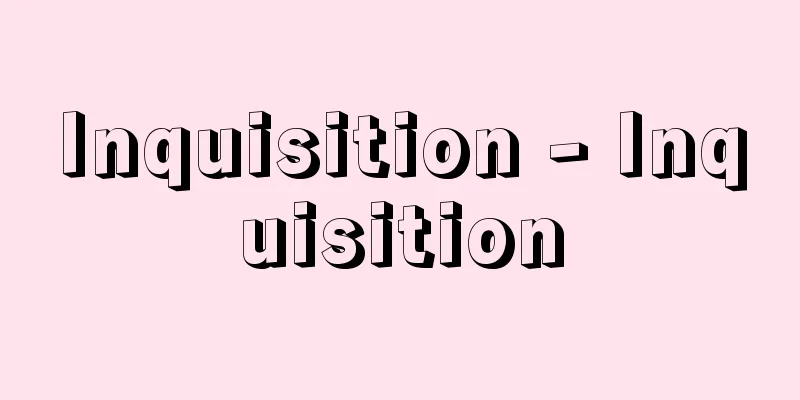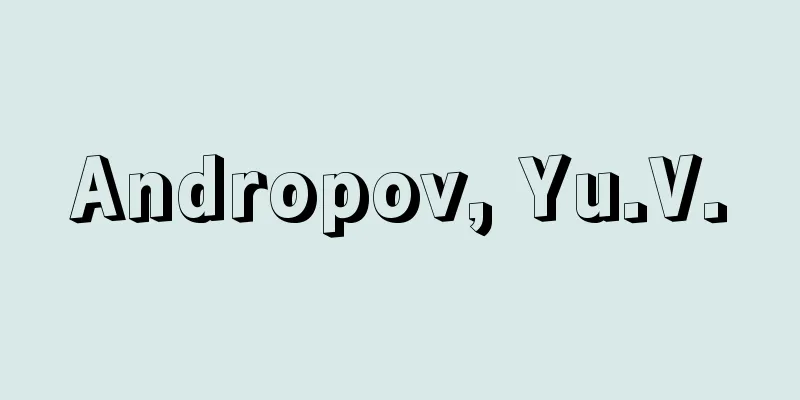Inquisition - Inquisition

|
A court established by the Catholic Church to pursue and punish heresy. It is also called the Inquisition, but it is separate from regular church (bishop) trials. [Masami Watanabe] Establishment of the systemHeresy was seen soon after the foundation of the church, but initially it was only excommunication. The Inquisition was formed during the crusades against the Cathars (Albigensians) that spread to southern France from the late 12th century, and was institutionalized by the Council of Toulouse in 1229 and the Bull of Gregory IX in 1232. This was a special emergency court directly under the Pope, and was not controlled by bishops, but rather bishops and secular authorities were expected to cooperate unconditionally. It worked without waiting for an accusation. The word "inquisition" means "in-person trial." A confession or two testimonies were enough to determine guilt, and witnesses did not have to confront the defendant. Torture was officially recognized, and denunciations were encouraged. It was administered by the Dominican and Franciscan orders. Usually, two inquisitors worked in pairs to travel around problematic areas. Their activities were prone to cause friction, and in 1242, in Avignonay near Toulouse, an inquisitor was attacked, and in the early 14th century, a riot led by Bernard Deliciu occurred in Carcassonne. However, since there were certain rules, not all of them were burned at the stake. Bernard Guy's "Essays of the Inquisitors" written in the 14th century gives a good account of the situation during this period. Furthermore, from today's perspective, the records of the testimonies are valuable historical materials that allow us to understand the actions and feelings of the people. [Masami Watanabe] Spanish InquisitionThe Inquisition system was first introduced in France, then Italy and Germany, but was not accepted in England or other Northern European countries. Although it was introduced late, it was Spain that established it most firmly and exerted its influence. It was established in 1478, almost at the same time as the establishment of the Kingdom of Spain (1479). The king held the power to appoint inquisitors, and it was completely incorporated into the royal governing system, escaping from the control of the Pope. Even semi-legendary figures appeared, such as the inquisitor general Tomás de Torquemada (1420-98), who single-handedly tried 100,000 cases and never let the smoke of the stake die down. At first, the main victims were Jews, or more precisely, false Jewish converts, but later the target was expanded to include any crime against morals. There is no way to know the total number of victims, but looking at just the Toledo district court out of the 14 district courts, the first peak was about 750 people punished in 1485, the second peak was about 250 people in 1650, and from the 18th century onwards the average was about 50 people per year. Apart from the interruption during the Napoleonic period, it was not until 1834 that it was officially abolished. [Masami Watanabe] "The Inquisition" by Guy Testas and Jean Testas, translated by Kazuo Anzai (Hakusuisha, Que sais-je Bunko) Source: Shogakukan Encyclopedia Nipponica About Encyclopedia Nipponica Information | Legend |
|
カトリック教会が異端追及と処罰のために設置した法廷。宗教裁判ともいうが、通常の教会(司教)裁判とは別である。 [渡辺昌美] 制度の確立異端発生は教会の成立直後からみられるが、当初は破門するだけであった。12世紀後半から南フランスに広がったカタリ派(アルビジョア派)に対する十字軍の過程で異端審問が形成され、1229年のトゥールーズ教会会議と1232年のグレゴリウス9世勅書で制度的に確立をみた。これは教皇直属の特設非常法廷で、司教の統制を受けず、逆に司教や世俗権力は無条件に協力すべきものとされた。告訴を待たずに活動する。インクィジションとは「立入り審理」の意である。自供、または2名の証言をもって有罪を判決しえ、証人は被告と対決する必要がなかった。拷問が公認され、密告を奨励した。ドミニコ会とフランチェスコ会により担当された。通例、審問官2名が1組となって、問題の多い地方を巡回した。その活動は摩擦を生じやすく、1242年にはトゥールーズに近いアビニョネで審問官が襲撃され、14世紀初頭にはカルカソンヌでベルナール・デリシウの指導する暴動がみられた。ただしそれなりの準則はあったので、全部を火刑にしたわけではない。14世紀、ベルナール・ギーが著した『審問官必携』は、この間の事情をよく示している。また、今日からみれば、供述の記録は民衆の行動と心情を知るための貴重な史料である。 [渡辺昌美] スペインの異端審問異端審問の制度は、まずフランス、ついでイタリア、ドイツに展開したが、イギリスや北ヨーロッパ諸国には受け入れられなかった。遅れて導入されながら、もっともよく定着して猛威を振るったのはスペインである。設立は1478年、スペイン王国の成立(1479)とほぼ同時期である。審問官任命権は国王が握り、完全に王国統治機構の一環に組み込まれて、教皇の統制から逸脱し、1人で10万件を審理して火刑台の煙を絶えさせなかったという審問官総長トルケマダTomás de Torquemada(1420―98)のごとき、なかば伝説的な人物すら出現した。初め主たる犠牲者はユダヤ教徒、厳密には偽装改宗ユダヤ人であったが、のちには風紀事犯一般に対象が拡大された。犠牲者総数は知る由もないが、全14地区法廷のうちトレド地区だけをみても、第一ピークたる1485年に処罰者約750人、第二ピーク1650年に約250人、18世紀以降は毎年平均50人程度であった。ナポレオン支配期における中断を別にすれば、正式に廃止されたのは1834年のことであった。 [渡辺昌美] 『ギー・テスタス、ジャン・テスタス著、安斎和雄訳『異端審問』(白水社・文庫クセジュ)』 出典 小学館 日本大百科全書(ニッポニカ)日本大百科全書(ニッポニカ)について 情報 | 凡例 |
Recommend
Forensic Anthropology
This refers to the study of law through anthropol...
Ausräumungsbecken (English spelling)Ausraumungsbecken
...A long, narrow basin bounded by two parallel f...
Hymn of Love - Ainosanka (English) Hymne à l'amour
A famous chanson song. The lyrics were written by...
Foot soldiers - Kachigumi
A job title in the Edo Shogunate. It is said to h...
The Perils of Pauline
…American serials were linked to newspaper fictio...
Boron nitride (boron nitride)
Chemical formula: BN. It is produced by mixing sod...
Request - Ukebumi
A style of ancient document. Especially in the Mi...
Blocking oscillator - Blocking oscillator
A type of sawtooth wave oscillator in which vacuum...
Aikman
Dutch physiologist. He obtained his medical docto...
Buried object - Umemono
〘 noun 〙 Decoration of lacquerware and other craft...
spirogram
...However, the lungs have a large functional res...
Comparative grammar
…A major field of historical linguistics. Also kn...
Rai Sanyo
A Chinese poet and historian of the late Edo peri...
Mongol Invasion - Mongol Invasion
The Mongol invasion of Japan took place twice, in ...
A glimpse - Omemie
In the old days, it was called genzan. It meant h...









